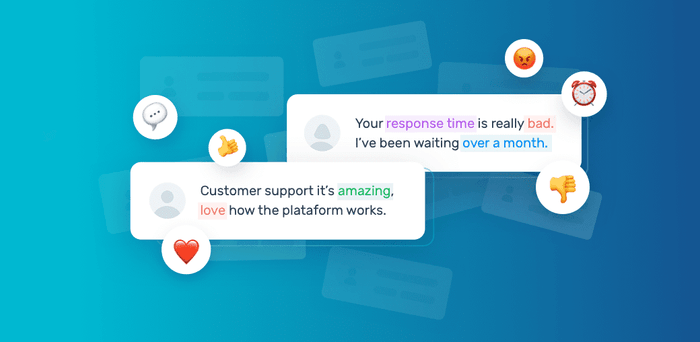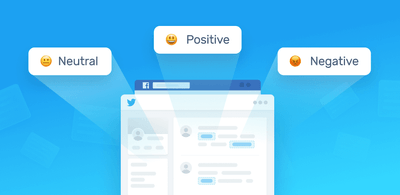5 Sentiment Anlysis Examples in Business

Positive and negative opinions are powerful because they can boost or ruin a brand’s reputation. Did you know that 40% of buyers form an opinion of a business after reading 1-3 online reviews?
This gives you an idea of how important it is to track the sentiment of conversations around your brand, whether in reviews, surveys, social media, emails, and more.
Dealing with huge amounts of data can be a struggle when done manually. But with AI techniques, like sentiment analysis, you can automatically identify the emotional tone in a text – in real time, at scale, and accurately.
Thanks to Natural Language Processing (NLP), sentiment analysis systems can understand opinions in all types of customer feedback, enabling you to obtain valuable insights about your brand, products or services.
Discover the different applications of sentiment analysis and no-code sentiment analysis tools.
- What Is Sentiment Analysis?
- Examples of Sentiment Analysis
- Types of Sentiment Analysis
- Creating a Custom Sentiment Analyzer
What Is Sentiment Analysis?
Sentiment analysis is an automated process capable of understanding the feelings or opinions that underlie a text. It is one of the most interesting subfields of NLP, a branch of Artificial Intelligence (AI) that focuses on how machines process human language.
Sentiment analysis studies the subjective information in an expression, that is, the opinions, appraisals, emotions, or attitudes towards a topic, person or entity. Expressions can be classified as positive, negative, or neutral. For example:
- “I really like the new design of your website!” →
Positive - “I’m not sure if I like the new design” →
Neutral - “The new design is awful!” →
Negative
Examples of Sentiment Analysis
Sentiment analysis is a powerful tool, which can be used across industries and teams. Learn about some of the most popular sentiment analysis business applications, below:
- Social media monitoring
- Brand monitoring
- Customer support analysis
- Customer feedback analysis
- Market research
Social Media Monitoring
There are more than 3.5 billion active social media users; that’s 45% of the world’s population. Every minute users send over 500,000 Tweets and post 510,000 Facebook comments, and a large amount of these messages contain valuable business insights about how customers feel towards products, brands and services.
Sentiment analysis allows businesses to mine this data and extract the feelings that underlie social media conversations, to understand how people are talking about a given product or topic, and why.

51% of social media users have ‘called out’ a company on social media, which explains why brands are changing the way they engage with their audiences. They need to respond quickly, effectively, and personally, to turn bad situations into positive experiences. Something that is only possible with AI tools like sentiment analysis.
With sentiment analysis tools, restaurants, retail stores, internet providers, and airlines – which are often the most called-out industries on social media – can quickly detect dissatisfied customers, categorize issues by urgency, and prioritize responses.
Real-time sentiment analysis can even put you one step ahead of a potential PR crisis, allowing you to take action before a customer’s bad experience goes viral.
You might also want to use sentiment analysis to analyze the competition by tracking how customers are talking about them and finding opportunities to improve your own business.
Play around with this twitter sentiment analysis tool, which detects comments about @AmericanAir and @VirginAtlantic and automatically tags them as positive, negative, or neutral:
Brand Monitoring
Besides social media, online conversations can take place in blogs, review websites, news websites and forum discussions. Product reviews, for instance, have become a crucial step in the buyer’s journey. Consumers read at least 10 reviews before buying, and 57% only trust a business if it has a star-rating of 4 or more.
Sentiment analysis is an excellent tool to keep a close eye on your brand’s reputation, find out what is right or wrong about your business, and understand more about your customers.
If you need to get detailed insights on different features related to your product, you should try aspect-based sentiment analysis. This will allow you to see what specific aspects of your product are being praised or criticized by customers.
For example, let’s look at how an aspect-based model would classify a set of Drift reviews:

Sentiment analysis can also be helpful to monitor online conversations at a specific point in time, for example, if you are launching a new product, releasing a new update or starting a new marketing campaign.
Ready to see how it works by yourself? Here’s a pre-trained sentiment analysis model for product reviews:
Customer Support Analysis
Providing outstanding customer service experiences should be a priority. After all, 96% of consumers say great customer service is a key factor to choose and stay loyal to a brand.
Fortunately, sentiment analysis can help you make your customer support interactions faster and more effective.
If you run sentiment analysis on all your incoming tickets, you can easily detect the most dissatisfied customers or the most urgent issues and prioritize them above the rest.Plus, you could route tickets to the appropriate person or team in charge of dealing with them.
You can also use sentiment analysis to assess the results of your customer support strategy. Let’s take this Tweet complaining about Airbnb customer support:

By analyzing sentiment on customer support chats or tweets referring to interactions with your customer support team (like the one above), you can get relevant insights regarding customer satisfaction and detect clear opportunities for improvement.
Customer Feedback Analysis
Net Promoter Score (NPS) surveys are one of the most popular ways to ask for customers feedback about a product or service. Sentiment analysis of NPS surveys allows you to go beyond the numerical scores and groups (Detractors, Promoters, Passives), as well as speed up the process and obtain more consistent results than if you were tagging these results manually.
Let’s say a customer gave your business a score of ‘7’, and then added: 'The product is decent, but your website is so confusing it took me forever to find the product I was looking for'.
By running aspect-based sentiment analysis on a set of open-ended NPS responses, you’ll gauge sentiments regarding specific features of your product. That way, you’ll find out what customers appreciate and dislike most about your product. Once your sentiment analysis process is up and running, you’ll also be able to compare results with previous NPS surveys and see how sentiments toward aspects of your product have improved over time.
Market Research
Want to collect insights on customer feelings, experiences, and needs relating to a marketing campaign for a new product release? Sentiment analysis can help monitor online conversations about a specific marketing campaign, so you can see how it’s performing.
You can also find out how customers feel about a new product. Is it already getting positive or negative feedback ahead of its release. Perhaps customers are unhappy with the pricing or would have liked to see an additional feature.
Let’s take the case of foldable phones, for example:

Performing sentiment analysis of tweets referring to the topic ‘foldable phones’ will allow you to understand how people feel about this product: do they find it exciting? Do they think it may be a useful product? Would they buy it?
Types of Sentiment Analysis
As you can see from the previous examples, it is possible to build sentiment analysis models oriented to different purposes. Even though the most common type of sentiment analysis focuses on polarity (classifying an opinion as positive, negative, or neutral), other types may focus on detecting feelings, emotions, or intentions.
These are the most common types of sentiment analysis:
- Standard sentiment analysis
- Fine-grained Sentiment Analysis
- Emotion detection
- Aspect-based sentiment analysis
- Intent detection
Standard Sentiment Analysis
It identifies the nuance of an opinion and classifies it as Positive, Negative, or Neutral. It’s the most popular type of sentiment analysis. For example:
- 'I love how Zapier takes different apps and ties them together' →
Positive - “I still need to further test Zapier to say if its useful for me or not' →
Neutral - “Zapier is sooooo confusing to me' →
Negative
Fine-grained Sentiment Analysis
Also focused on polarity, this type of sentiment analysis adds a few more categories to obtain more granular results. Similar to 5-star ratings, it classifies opinions as:
- Very positive
- Positive
- Neutral
- Negative
- Very negative
For example, imagine having the following survey responses:
- 'The older interface was much simpler' →
Negative - 'Awful experience. I would never buy this product again!' →
Very Negative - 'I don't think there is anything I really dislike about the product' →
Neutral
Emotion Detection
This sentiment analysis model detects the emotions that underlie a text. It makes associations between words and emotions like anger, happiness, frustration, etc. For example,
- 'Hubspot makes my day a lot easier :)' →
Happiness - 'Your customer service is a nightmare! Totally useless!!' →
Anger
Aspect-based Sentiment Analysis
This type of sentiment analysis focuses on understanding the aspects or features that are being discussed in a given opinion. Product reviews, for example, are often composed of different opinions about different characteristics of a product, like Price, UX-UI, Integrations, Mobile Version, etc. Let’s see some examples:


Intent Detection
This type of sentiment analysis tries to find an action behind a given opinion, something that the user wants to do. Identifying user intents allows you to detect valuable opportunities to help customers, such as solving an issue, making improvements on a product or deriving complaints to the correspondent areas:
- “Very frustrated right now. Instagram keeps closing when I log in. Can you help?” →
Request for Assistance
Customers experiencing issues can be easily spotted thanks to sentiment analysis.
Perform Sentiment Analysis & Keyword Extraction
MonkeyLearn’s templates make it really simple for you to get started with sentiment analysis. All you need is your data set. Once you have your data, follow the steps below.
1. Choose Keyword + Sentiment Analysis template

2. Upload your text data

If you don't have a CSV, use our sample dataset.
3. Match the CSV columns to the dashboard fields

In this template, there is only one field: text. If you have more than one column in your dataset, choose the column that has the text you would like to analyze.
4. Name your workflow

5. Wait for your data to import

6. Explore your dashboard!

You can:
- Filter by sentiment or keyword.
- Share via email with other coworkers.
Final Words
Sentiment analysis provides amazing insights on customers’ feelings and opinions.
What are the things that people like or dislike about your brand? What are their favorite features of your product? Which aspects require more improvement? How do they feel about your company’s customer service? These are just a few of the many questions that can be answered through sentiment analysis.
The possibilities of machines capable of understanding the human language are endless, and thanks to platforms like MonkeyLearn, you don’t need to be a machine learning expert to get a sentiment analysis model up and running. Sign up for free or request a demo to get started.

Inés Roldós
July 20th, 2020






